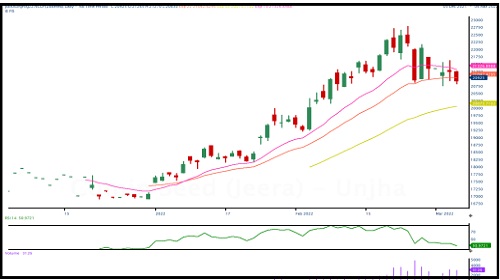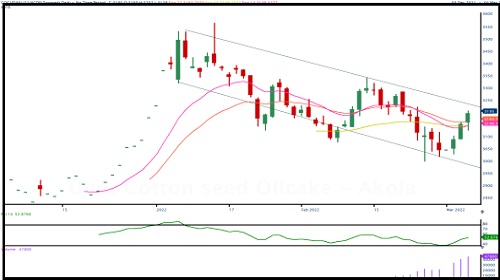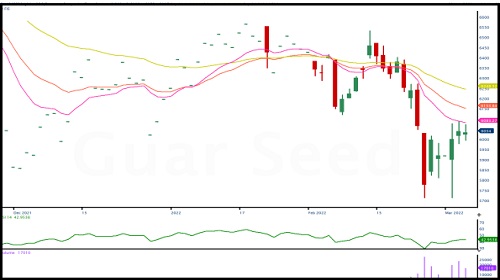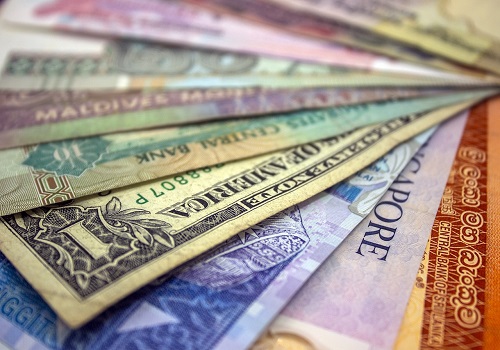Agri Picks Daily Technical Report 07 March 2022 - Geojit Financial

Follow us Now on Telegram ! Get daily 10 - 12 important updates on Business, Finance and Investment. Join our Telegram Channel
SPICES
Spices complex on NCDEX ended Friday’s session in red. Jeera March futures slid more than 1.5 per cent on rise in arrivals in the spot market. Turmeric April futures too declined more than 1.5 per cent after rising for the last three straight days. In the meantime, losses in Coriander April futures were limited, probably on forecast of lower production this rabi season.
According to the second advance estimates by Gujarat state agriculture department, jeera production is seen declining to 236980 tons in 2021-22, down 41 per cent year on year. Area is seen at 289000 ha as against 473800 ha a year ago. Coriander production is seen declining as well to 211680 tons compared to 221240 tons in 2020-21.
Exports of spices from India during Apr-Sep declined 8% on year to 780,273 tn, according to data from the Spices Board India.
Spices Board pegs Apr-Sep jeera exports at 139,295 ton, down 14%.
Spices Board pegs Apr-Sep turmeric exports at 77,245 ton, down 26%.
Spices Board pegs Apr-Sep pepper exports at 10,844 ton, up 24%
Spices Board pegs Apr-Sep small cardamom exports 4,240 ton, up 101%.
Spices Board pegs Apr-Sep coriander exports at 24,459 ton, down 13%
India exported 299,000 tn of jeera in 2020-21, up 40% on year according to the Spices Board.
According to Spices Board, Coriander exports from India were up 21% on year at 57,000 ton.
Government sees 2020-21 coriander output at 720000 tons compared to 701000 tons a year ago.
Spices Board sees exports of turmeric up 33% to 183000 tonnes in FY 2020-21 on yoy basis.
Government sees 2020-21 turmeric output at 1.11 million tonnes compared to 1.15 million tons a year ago.
Spices Board pegs FY21 small cardamom export 6,500 ton, up 251% on year
Output of small cardamom is seen rising by 100% on year to 22520 tons according to the Spices Board.

COTTON
The International Cotton Advisory Committee has raised its price forecast of Cotlook A Index, a global benchmark for prices of raw cotton, to 109 cents per pound, up by 5 cents from the previous estimate. In 2021-22 (Aug-Jul) season, the committee estimated global ending stocks at 20.8 mln tn, higher than 20.4 mln tn in the previous season. Global consumption is seen almost steady at 25.7 mln tn. The agency sees global export for the season at around 10.0 mln tn, as against 10.6 mln tn a year ago. Global production for the ongoing season is estimated at 26.1 mln tn, compared with 24.3 mln tn in the previous season. The rise has largely been attributed to higher production in Brazil and the US. In the US, cotton production is estimated at 3.8 mln tn, against 3.2 mln tn a year ago. Output in India is expected to be 5.8 mln tn, compared with 6.0 mln tn in the previous year
The UK-based Cotton Outlook has scaled up its estimate for global production in 2021-22 (Aug-Jul) by 25,000 tn to 25.7 mln tn in its February report. The estimate has been revised upwards as production in Australia is expected to be higher. The agency has also raised its estimate for global consumption in 2021-22 by 25,000 tn to 25.95 mln tn. Global cotton ending stocks for the ongoing 2021-22 season are estimated at 254,000 tn
The Cotton Association of India has reduced its production estimate for the 2021-22 (Oct-Sep) marketing season to 34.3 mln bales from 34.8 mln bales projected a month ago. The reduced estimate can be attributed to some crop loss because of excess rain in November, in the key producing states which impacted crop quality. Of the total crop, around 19.2 mln bales had arrived in markets across India till January. Exports in the ongoing marketing year have been revised downward to 4.5 mln bales, as against 4.8 mln bales estimated earlier. India shipped around 2.5 mln bales of cotton till January. The association has also lowered its estimate for domestic cotton consumption to 34.0 mln bales and imports are maintained at 1.5 mln bales. The ending stock for the 2021-22 season has been estimated at 4.8 mln bales, as against 4.5 mln bales projected a month ago. Govt pegs 2021-22 cotton output at 34.1 mln bales vs 35.2 mln bales
A surge in prices in the domestic market has made India's cotton uncompetitive, weighing on exports of the commodity in the 2021-22 (Oct-Sep) season. Domestic prices have been at elevated levels due to tight supply, as a sharp rise in domestic mill consumption and a decline in production have led to a drop in ending stock estimates, market participants said. In the ongoing marketing year, around 2.6 mln bales of cotton were exported till January, lower than in the year-ago period. In 2020-21, India had shipped 2.9 mln bales during Oct-Jan, according to trade sources. Most consignments this season have been shipped to Bangladesh, followed by China, Indonesia and Vietnam. China isn't actively buying this year. Industry experts say cotton exports this season might stand at 4.0-4.5 mln bales. In the 2020-21 marketing year, India exported 7.5-7.8 mln bales of cotton, with Bangladesh, China and Vietnam being the major buyers.
The US Department of Agriculture's Foreign Agricultural Service has further scaled down its estimate for cotton output in India in 2021-22 (Aug-Jul) to 27.4 mln bales (1 US bale = 218 kg) from 27.7 mln bales projected in January. The reduction in cotton output estimate is attributed to crop damage due to rains in late September in key producing regions of Telangana. Meanwhile, the agency has raised its estimate for India's cotton consumption in 2021-22 to 26.5 mln bales from 26.0 mln bales estimated a month ago. Trade sources indicate that mill consumption is being supported by robust textile and apparel exports. Mills are reporting good margins and making investments in additional spinning capacity for the long-term. Exports during the season are maintained at 5.9 mln bales with Bangladesh, Vietnam, China, and Indonesia being the top export destinations. Bangladesh continues to be the major buyer of Indian cotton with almost 60% export market share. The estimate for imports into India in the 2021-22 crop year has been maintained at 1.0 mln bales. The closing stock of cotton for the country has been pegged at 9.7 mln bales, compared with 10.8 mln bales estimated the previous month
The new season for cotton which started on Oct 1, is expected to be good for farmers as the market price of the fibre is currently more than the minimum support price, due to firm demand and a rise in global prices.
Sowing of cotton across the country has ended and farmers have sown the crop across 12 mln ha in the 2021-22 (JulJun) kharif season, down 6% from a year ago, data from the farm ministry
India's cotton output in the 2021-22 (Oct-Sep) marketing year is seen at 36.2 mln bales (1 bale = 170 kg), as per the median of estimates of 13 prominent players in the cotton value chain polled by Informist.
In the ongoing 2021-22 (Jul-Jun) season, cotton acreage across the country was 11.9 mln ha as on Thursday, down 5.8% from a year ago, data from the farm ministry showed

OTHERS
Canada's farm agency has revised downward its average price forecast of dry peas, lentils and chickpeas for 2021-22 (Aug-Jul), despite a sharp fall in the ending stocks, it said in a report for February. Citing information from Statistics Canada, the agriculture body sees the country's chickpea production in 2021-22 declining 64% on year to 76,000 tn due to poor yields, despite higher area. The average chickpea, or chana, price estimate for the season has been revised downwards to $1,000 from $1,065 projected a month ago. With an estimated production of 76,000 tn this year, the country's total chickpea supply is forecast to fall to 371,000 tn from 506,000 tn projected in the previous year. Carryover stocks in 2021-22 are forecast to decline to 150,000 tn, compared with 275,000 tn a year ago, the report said
Farmers across the country have sown chana across 11.49 mln ha in the 2021-22 (JulJun) rabi season, up 4.1% on year, according to data from the farm ministry. Chana sowing so far has been higher in Madhya Pradesh, Maharashtra, Gujarat, and Uttar Pradesh, while it declined in Karnataka, Chhattisgarh, and Rajasthan. The acreage in Madhya Pradesh, the largest producer, was up 0.9% on year at 2.51 mln ha, and in Maharashtra, the second-largest grower, it rose 9.4% on year to 2.71 mln ha. The area in Gujarat rose significantly by 34.5% on year to 1.10 mln ha. On other hand, the acreage fell in Rajasthan by 1.0% on year to 2.04 mln ha, and in Karnataka by 6.1% on year to 1.10 mln ha.
The Securities and Exchange Board of India has asked the National Commodity and Derivatives Exchange to not launch any new chana contracts on its platform till further notice, the market regulator said in a release on August 16, 2021.
Government raises MSP for Rabi crops for season 2022-23. MSP for chana has increased by 2.5 % to Rs. 5230/qtl. against Rs. 5100/qtl previous year.
India’s guar gum exports increased in the month of December 2021 by 44.70% to 25,274 tonnes compared to 17,466 tonnes during previous month at an average FoB of US $ 2466 per tonne in the month of Dec’2021 as compared to US $ 2169 per tonne previous month. Further, the gum shipments were up by 43.24% in Dec’2021 compared to the same period last year. Of the total exported quantity, around 7,671 tonnes bought by US, Russia bought 6,964 tonnes, Germany 3,092 tonnes, China 1,036 tonnes, Australia 835 tonnes and Canada 687 tonnes.
India’s guar split exports too increased in the month of Dec’2021 by 24.73% to 3,268 tonnes compared to 2,620 tonnes previous month at an average FoB of US $ 1,639 per tonne in the month of Dec’21 compared to US $ 1,557 per tonne previous month. However, the guar split shipments gone up by 16.71 % in Dec’21 2021 compared to the same period last year. Of the total exported quantity, around 1,360 tonnes bought by China, US 960 tonnes, Mexico 528 tonnes and Switzerland 240 tonnes.
According to Rajasthan govt 2021-22 second advance estimates, Guar seed production is seen a tad down at 1.1 mln tn. 2021-22 acreage stood at 21.13 lakh hectare as compared to 24.84 lakh hectare last year
Thailand is expecting to produce 4.9 million tonnes of natural rubber in 2022, up 1.82% from a year earlier, its rubber agency said. The Southeast Asian country also expects to export about 4.22 million tonnes of it this year, 2% more than in 2021, said Athiwee Dangkanit,anofficial at the Rubber Authority of Thailand.
According to The Association of Natural Rubber Producing Countries, in its December release of theNatural Rubber Trends, despite the global economy was hit badly by Covid-19 pandemic in 2020, the natural rubber (NR) industry posted a strong recovery in demand with an 8.7% growth in 2021; while the production of NR recorded at 1.7% growth as compared to the previous year.

OILSEED
With the shortage of edible oil supply from imports due to the crisis in Ukraine, the Soybean Processors Association of India has recommended measures to augment the supply and cool down prices. The agency estimates a shortfall of edible oil supply from imports due to the war of approximately 200,000 tn a month of sunflower oil, it said in a note.
The National Commodity & Derivatives Exchange will launch future contracts in refined castor oil on Mar 21, the bourse said in a circular. According to the contract specification the commodity will have trading unit of 2 tn, with the maximum order size of 200 tn. The contract will be settled in cash. The open interest threshold level to attract concentration margin in the commodity will be 17,900 tn.
India's oilmeal exports fell 64.7% on year to 176,815 tn in January, according to data released by The Solvent Extractors' Association of India. For Apr-Jan, exports of oilmeal were down 34.5% on year at 1.94 mln tn. Soymeal exports plunged to 315,108 tn during Apr-Jan, compared with 1.17 mln tn a year ago, because of the higher price of the Indian variant in international markets. India's exports are unlikely to be competitive in the next two-three months due to high domestic prices of soybean seed, it said. Lower crushing of soybean also led to higher import of crude soybean oil. Mustard meal exports in Apr-Jan fell 26.4% on year to 729,757 tn, while exports of castor meal were down 13.5% on year at 317,606 tn . Currently, availability of mustard seed for crushing is almost over, and the new crop will arrive around February-end or early March.
India's vegetable oil imports in January rose 16% on year to 1.27 mln tn, according to SEA. Edible oil imports were at 1.25 mln tn in January against 1.07 mln tn a year ago, and for Nov-Jan the edible oil imports stood at 3.61 mln tn, as against 3.49 mln tn year-on-year. In January, import of crude palm oil was at 407,620 tn, as against 767,836 tn during the same month las year. As on Feb 1, 654,000 tn of edible oil was at ports, against 657,000 tn a year ago, while 1.21 mln tn was in the pipeline, against 1.13 mln tn during the same period last year.
The government cut agriculture cess on crude palm oil and extended the lower customs duty on edible oils by six months till Sep 30 to cool domestic prices. The government cut Agriculture Infrastructure and Development Cess on crude palm oil to 5.0% from 7.5%, a finance ministry notification said. The Centre had in October slashed import duty on key edible oils till Mar 31. This has now been extended till Sep 30, the notification said.
Soymeal exports in January fell sharply by 68.2% on year to 100,000 tn, the Soybean Processors Association of India said in a release. During Oct-Jan, soymeal exports slumped to 362,000 tn from 1.0 mln tn a year ago, the release said. In January, soymeal production fell to 519,000 tn from 998,000 tn a year ago, while during Oct-Jan, output was at 2.2 mln tn, lower than 3.7 mln tn during the same period a year ago. Soybean arrivals in spot markets were pegged at 800,000 tn in January, down from 1.2 mln tn last year. During Oct-Jan, arrivals declined to 4.8 mln tn from 6.4 mln tn during the same period last year.By the end of January, mills, traders, and farmers were left with around 8.4 mln tn of soybean stock.
The government will implement a comprehensive scheme to increase domestic production of oilseeds to reduce the country's dependence edible oil imports, according to the Union Budget presented by Finance Minister Nirmala Sitharaman in the Lok Sabha.
Farmers have sown mustard across 9.16 mln ha in the country, up 25.3% on year, in the ongoing 2021-22 (Jul-Jun) rabi season as of Friday, according to the farm ministry's data. The government fixed the minimum support price of the crop at 5,050 rupees per 100 kg for the 2022-23 (Apr-Mar) marketing season, as against 4,650 rupees in the previous year.
The Solvent Extractors' Association has urged the Centre and the Securities and Exchange Board of India to resume futures trade in mustard seed on the National Commodity and Derivatives Exchange.
In its January report, the US Department of Agriculture has scaled down its estimate for global soybean production in 2021-22 to 372.6 mln tn from 381.8 mln tn pegged in the previous month's report. The lower estimate is largely attributed to a decline in output in South American countries, including Brazil. The department lowered the soybean production estimate for Brazil for 2021-22 by 5 mln tn to 139 mln tn because of dry weather conditions in south Brazil in December. The estimate for global ending stocks for 2021-22 has been scaled down to 95.2 mln tn from 102 mln tn pegged the previous month. The global soyoil production estimate for 2021-22 has been revised downwards to 61.3 mln tn from 61.6 mln tn. Similarly, the global soyoil export estimate for 2021-22 has been revised marginally lower to 12.5 mln tn from 12.7 mln tn estimated the previous month. Also, the estimated global soymeal output for 2021-22 has been revised downwards to 255.9 mln tn from 257.6 mln tn, according to the report. The estimate for global exports of soymeal in 2021-22 has been cut marginally to 69.9 mln tn from 70.8 mln tn in December. According to the report, global oilseed production in 2021-22 is seen lower at 619.2 mln tn against 627.6 mln tn pegged in December, due to a decline in soybean output in Brazil. Global vegetable oil output in 2021-22 is estimated at 213.9 mln tn, against a projection of around 215.0 mln tn in December.
The Solvent Extractors' Association has urged the government to exempt soyoil from genetically-modified labelling requirement as it may lead to a rise in prices, it said in a letter. Last year, according to reports, the Centre had asked states to enforce separate labelling for genetically-modified soyoil to help consumers make informed decision.
The Centre has included soymeal under the Essential Commodities Act with immediate effect till Jun 30 to regulate production, stocking, and distribution of the commodity.
The government has reduced the basic import duty on refined, bleached, and deodorised palm oil, to cool domestic prices, the finance ministry said in a notification. The new duty rates will be in place till Mar 31, the ministry said. The effective basic import duty on refined, bleached, and deodorised palm oil has been reduced to 12.5% from 17.5% earlier. With the new duty cut, the duty difference between crude palm oil, which is a raw material, and refined, bleached, and deodorised palm oil, which is the finished product, has reduced to 5.5% from 11.0% earlier.
The Securities and Exchange Board of India asked exchanges not to launch new contracts of some farm commodities, including those of soybean and its derivatives, and crude palm oil. The restrictions come into effect immediately and shall be applicable for one year.
The Central Organisation for Oil Industry and Trade has estimated India's mustard output in the 2021-22 (Jul-Jun) rabi season at 10-11 mln tn because of increase in acreage, it said in a release. In 2020-21 the country produced around 8.5 mln tn of mustard, which is a crucial oilseed sown in the rabi season during Sep-Oct and harvested from February.
India's 2020-21 (Jul-Jun) mustard output is seen rising 22.6% on year to 8.95 mln tn, according to a joint survey by the Central Organisation for Oil Industry and Trade and the Mustard Oil Producers' Association.
The government reduced the effective import duty on CRUDE PALM OIL to 8.25% from 24.75%, and the effective import duty on REFINED SOYOIL to 19.25% from 35.75%
India's soybean acreage in the 2021-22 (Jul-Jun) kharif season remained unchanged at 12.2 mln ha, agri ministry.
The government allowed the import of 1.2 mln tn of genetically-modified soymeal till Oct 31 to augment supply in domestic markets, the Directorate General of Foreign Trade said in a notification.
Malaysia's crude palm oil output fell 13.5% on month to around 1.3 mln tn in January, data from the Malaysian Palm Oil Board showed. Export of palm oil in January fell nearly 19% on month to 1.2 mln tn, and those of outbound shipments of biodiesel rose sharply by 91.5% on month to 29,375 tn. The total palm oil stocks in the country decreased 3.9% on month to around 1.6 mln tn as of Jan 31.
Malaysia's palm oil exports during Feb 1-20 were estimated at 818,293 tn, up 29% on month, data by cargo surveyor AmSpec Agri Malaysia showed.
Acreage under oil palm in north-eastern states is likely to increase by 50-60% by 2025 depending on the availability of seedlings, a farm ministry source said.
Indonesia's crude palm oil output is expected to rise 2.6% next year to 51.01 million tonnes from a 2021 estimate of 49.71 million tonnes, head of the Estate Crop Fund Eddy Abdurrachman said. Agri Picks, 07.03.2022 TECHNICAL LEVELS
To Read Complete Report & Disclaimer Click Here
For More Geojit Financial Services Ltd Disclaimer https://www.geojit.com/disclaimer
SEBI Registration Number: INH200000345
Views express by all participants are for information & academic purpose only. Kindly read disclaimer before referring below views. Click Here For Disclaimer












 320-x-100_uti_gold.jpg" alt="Advertisement">
320-x-100_uti_gold.jpg" alt="Advertisement">












